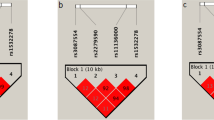Abstract
The purpose of this study is to evaluate whole lysyl oxidase like 1 (LOXL1) gene by sequence analysis in Turkish patients with exfoliation glaucoma (XFG). A total of 48 (35 male, 13 female) patients with XFG were enrolled. Besides routine ophthalmological examination, peripapillary retinal nerve fibre layer (RNFL) analysis with optic coherence tomography was performed. Blood samples of 2 ml with EDTA were obtained and sent to Medical Genetics Department, Molecular Genetics Laboratory for LOXL1 polymorphism (PCR and agarose gel imaging) analysis. The role of the detected changes on disease severity was evaluated. No LOXL1 gene mutations in any of the patients were detected. Three types of single-nucleotide polymorphisms (SNPs) including R141L(rs1048661), A320A(rs41435250), and F184F were detected in 17 (35.3 %) patients. When compared, SNP-positive patients had thinner RNFL than SNP-negative patients (64.5 ± 17.6 and 66.1 ± 20.4 µ, respectively), and SNP-positive patients had higher cupping/disc ratio than SNP-negative patients (0.76 ± 0.2 and 0.70 ± 0.3, respectively). However, both values were not statistically significant (p = 0.966 and p = 0.539, respectively). When compared, R141L-positive patients had significantly thinner cornea thickness (516.11 ± 30.3 µ) than R141L-negative patients (556.69 ± 27.2 µ) (p = 0.004). There was not any statistical significant difference in the means of age, gender, BCVA, MD, PSD, IOP, number of hypotensive agents, and percent of glaucoma surgery (p > 0.05). In this study group of Turkish population, no LOXL1 mutations were found. No associations between the defined SNPs (A320A, R141L and F184F) and the severity of the disease were detected.
Similar content being viewed by others
References
Schlötzer-Schrehardt UM, Koca MR, Naumann GO, Volkholz H (1992) Pseudoexfoliation syndrome. Ocular manifestation of a systemic disorder? Arch Ophthalmol 110(12):1752–1756
Ritch R, Schlötzer-Schrehardt U, Konstas AG (2003) Why is glaucoma associated with exfoliation syndrome? Prog Retin Eye Res 22(3):253–275
Damji KF, Bains HS, Stefansson E et al (1998) Is pseudoexfoliation syndrome inherited? A review of genetic and nongenetic factors and a new observation. Ophthalmic Genet 19(4):175–185
Orr AC, Robitaille JM, Price PA et al (2001) Exfoliation syndrome: clinical and genetic features. Ophthalmic Genet 22(3):171–185
Allingham RR, Loftsdottir M, Gottfredsdottir MS et al (2001) Pseudoexfoliation syndrome in Icelandic families. Br J Ophthalmol 85(6):702–707
Maki JM (2009) Lysyl oxidases in mammalian development an certain pathological conditions. Histol Histopathol 24(5):651–660
Lucero HA, Kagan HM (2006) Lysyl oxidase: an oxidative enzyme and effector of cell function. Cell Mol Life Sci 63(19–20):2304–2316
Thorleifsson G, Magnusson KP, Sulem P et al (2007) Common sequence variants in the LOXL1 gene confer susceptibility to exfoliation glaucoma. Science 317(5843):1397–1400
Aragon-Martin JA, Ritch R, Liebmann J et al (2008) Evaluation of LOXL1 gene polymorphisms in exfoliation syndrome and exfoliation glaucoma. Mol Vis 14:533–541
Challa P, Schmidt S, Liu Y, Qin X et al (2008) Analysis of LOXL1 polymorphisms in a United States population with pseudoexfoliation glaucoma. Mol Vis 14:146–149
Hewitt AW, Sharma S, Burdon KP et al (2008) Ancestral LOXL1 variants are associated with pseudoexfoliation in Caucasian Australians but with markedly lower penetrance than in Nordic people. Hum Mol Genet 17(5):710–716
Mossböck G, Renner W, Faschinger C, Schmut O, Wedrich A, Weger M (2008) Lysyl oxidase-like protein 1 (LOXL1) gene polymorphisms and exfoliation glaucoma in a Central European population. Mol Vis. 14:857–861
Lemmelä S, Forsman E, Onkamo P et al (2009) Association of LOXL1 gene with Finnish exfoliation syndrome patients. J Hum Genet 54(5):289–297
Pasutto F, Krumbiegel M, Mardin CY et al (2008) Association of LOXL1 common sequence variants in German and Italian patients with pseudoexfoliation syndrome and pseudoexfoliation glaucoma. Investig Ophthalmol Vis Sci 49(4):1459–1463
Le A, Mukesh BN, McCarty CA, Taylor HR (2003) Risk factors associated with the incidence of open-angle glaucoma: the visual impairment project. Investig Ophthalmol Vis Sci 44(9):3783–3789
Young AL, Tang WW, Lam DS (2004) The prevalence of pseudoexfoliation syndrome in Chinese people. Br J Ophthalmol 88(2):193–195
Astrom S, Linden C (2007) Incidence and prevalence of pseudoexfoliation and open-angle glaucoma in northern Sweden: I. baseline report. Acta Ophthalmol Scand 85(8):828–831
Yalaz M, Othman I, Nas K, Eroğlu A et al (1992) The frequency of pseudoexfoliation syndrome in the eastern Mediterranean area of Turkey. Acta Ophthalmol 70(2):209–213
European Glaucoma Society (EGS) (2014) Classification and terminology. In: European glaucoma society eds. terminology and guidelines for glaucoma, 4th edn. PubliComm, pp 90–100
Pasquale LR, Kang JH, Wiggs JL (2014) Prospects for gene-environment interactions in exfoliation syndrome. J Glaucoma 23(8):64–67
Kasim B, Irkec M, Alikasifoglu M, Orhan M, Mocan C, Aktaş D (2013) Association of LOXL1 gene polymorphisms with exfoliation syndrome/glaucoma and primary open angle glaucoma in a Turkish population. Mol Vis 19:114–120
http://www.ncbi.nlm.nih.gov/projects/SNP/snp_ref.cgi?showRare=on&chooseRs=all&go=Go&locusId=4016
Willams SE, Whigham BT, Liu Y et al (2010) Major LOXL1 risk allele is reversed in exfoliation glaucoma in a black South African population. Mol Vis 21(16):705–712
Schlötzer-Schrehardt U, Hammer CM, Krysta AW et al (2012) LOXL1 deficiency in the lamina cribrosa as candidate susceptibility factor for a pseudoexfoliation-specific risk of glaucoma. Ophthalmology 119(9):1832–1843
Ozcura F, Aydin S, Dayanir V (2011) Central corneal thickness and corneal curvature in pseudoexfoliation syndrome with and without glaucoma. J Glaucoma 20(7):410–413
Alpeza-Dunato Z, Novak-Stroligo M, Kovacevic D, Caljkusić-Mance T (2011) Corneal thickness in pseudoexfoliative glaucoma. Coll Antropol 35(2):303–304
Shetty R, Sathyanarayanamoorthy A, Ramachandra RA et al (2015) Attenuation of lysyl oxidase and collagen gene expression in keratoconus patient corneal epithelium corresponds to disease severity. Mol Vis 21:12–25
Acknowledgments
This research was supported by Scientific Research Foundation of Ege University School of Medicine (2014-TIP-031). None of the authors have any proprietary interest.
Financial support
No financial support was received for this submission.
Author information
Authors and Affiliations
Corresponding author
Ethics declarations
Conflict of interest
None of the authors has conflict of interest with the submission.
Rights and permissions
About this article
Cite this article
Yilmaz, S.G., Palamar, M., Onay, H. et al. LOXL1 gene analysis in Turkish patients with exfoliation glaucoma. Int Ophthalmol 36, 629–635 (2016). https://doi.org/10.1007/s10792-016-0174-y
Received:
Accepted:
Published:
Issue Date:
DOI: https://doi.org/10.1007/s10792-016-0174-y




